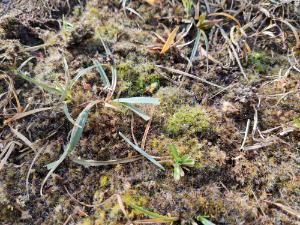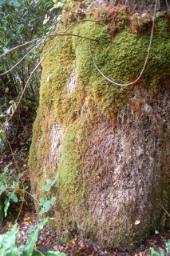A CSO Frontier Series Output- What is this?
| Active raised bogs | Raised bogs characterised by the presence of an actively peat-forming upper layer whose surface is composed mainly of living bog mosses (Sphagnum spp.)4. |  Location: Mount Hevey Bog; Taken by: Fernando Fernandez Location: Mount Hevey Bog; Taken by: Fernando Fernandez |
| Alkaline fens | Fens with extensive areas of species-rich small sedge and brown moss communities. They occur in areas with a high water table and a base-rich, often calcareous water supply4. | |
| Alpine and subalpine heaths | Alpine and Boreal heath consists of two distinct subtypes in Ireland. The upland subtype occurs on the exposed summits and upper slopes of mountains on acidic substrate. The lowland subtype comprises Dryas heath on limestone4. Alpine and subalpine heathland generally occurs from 400m altitude, below which they merge into dry heath4. | |
| Blanket bogs | Areas of consistently high rainfall (>1,250mm and >225 rain days per annum) where the ground surface is waterlogged for much of the time, resulting in the development of deep peats4. Blanket bogs are restricted to oceanic areas2. Blanket bogs are divided into Atlantic and Mountain blanket bogs. Atlantic Blanket bogs are found on flat or gently sloping ground in wetter regions along the western seaboard below 150m altitude, where the annual rainfall exceeds 1250 mm3. Mountain Blanket bogs are found on flat or gently sloping ground in Irish hills and mountains above 150m altitude3. |
|
| Bogs | Peatlands where most of the water inputs come from precipitation3. In Ireland, bogs can be divided into raised bogs, Atlantic blanket bogs and Mountain blanket bogs2,3. | |
| Cladium fens | Fens with a vegetation cover mostly dominated by Cladium mariscus4. | |
| Cutaway | Former industrial peat production bog. Cutaway bogs are out of peat production. | |
| Cutover | Former bog used for private peat/turf cutting. The harvest on bogs classified as cutover has ceased. | |
| Degraded raised bogs | Raised bogs characterised by the complete absence (or patchy thin cover) of an actively peat-forming upper layer but still capable of regeneration after implementation of restoration works4. |  Location: Scohaboy Bog; Taken by: Fernando Fernandez Location: Scohaboy Bog; Taken by: Fernando Fernandez |
| Disturbance | A discrete natural- or human - induced event which causes a change in the existing condition of an ecological system2. | |
| Dry heaths | Heathlands usually occurring on well-drained, nutrient-poor and acidic mineral soils or shallow peat soil (typically <50cm deep) on sloping ground. They merge into alpine and subalpine heathlands from 400m altitude4. | |
| Ecosystem | A dynamic complex of plant, animal and micro-organism communities and their non-living environment interacting as a functional unit13. | |
| Ecosystem goods and services | The contributions of ecosystems to benefits used in economic and other human activity7. | |
| Fens | Habitat receiving nutrients from surface or ground water as well as precipitation. Fens generally occur on peat soil as they are usually peat-forming2–4. | |
| Habitat | The environment in which species live. Habitats are generally defined in terms of physical and vegetation characteristics2. | |
| Heathlands | Habitat covered with low-growing vegetation dominated by bushes, shrubs, dwarf shrubs such as heather. Heathlands can have a peat soil and can be divided into dry heaths, wet heaths, montane heaths3. | |
| Montane heath | Montane heaths occur at high altitudes on mountains and other very exposed locations in the uplands or on the coast. They are usually associated with shallow mineral or peat soils3. | |
| Moors | In Britain, moors are upland habitats, with potential presence of peat soil and often covered by heath2. The term moors is not commonly used in Ireland. | |
| Mosaic habitat | Area composed of multiple types of habitats. | |
| Peat | Sedentary accumulation of material consisting of at least 30% (dry mass) of dead organic material2. | |
| Peat bogs | Acidic and nutrient-poor peatlands. There are two main types of peatbogs: raised bogs and blanket bogs (Mountain and Atlantic). The main differences between them are the type of vegetation and the depth of peat soil2,3. | |
| Peatlands | Wetlands with presence of peat soil. Peatlands are divided into two broad categories: bogs and fens. | |
| Peat production | Term widely used in the Irish industry which refers to the overall processes involved in producing peat for commercial operations2. | |
| Peat soil | Soil which contains peat over a depth at least 45cm on undrained land and 30cm on drained land1,2. | |
| Petrifying springs | Springs that are irrigated and kept permanently moist by calcareous and oligotrophic water. They may be associated with shallow peaty or skeletal mineral soils3. Although classified as “Springs” in the Heritage Council Classification (Fossitt, 2000)3, they are reported as “calcareous fens” in Annex I habitat of the EU Directive on the Conservation of Habitats, Flora and Fauna (92/43/EEC). |  Location: Knocknareagh; Taken by: Peter Foss Location: Knocknareagh; Taken by: Peter Foss |
| Poor fens | Peat-forming habitats fed by groundwater and flowing surface waters that are acid3. | |
| Raised bogs | Accumulations of deep acid peat (3-12m) that originated in shallow lake basins or topographic depressions. Raised bogs are shaped like a dome or elevated above the surrounding land2,4. | |
| Rehabilitation of peatlands | Rehabilitation refers specifically to former peat production areas (whether industrial or not). It usually involves similar techniques to those of restoration such as re-wetting and vegetation restoration. Peatlands under rehabilitation have often changed too drastically to allow restoration to functional peatlands, and, where it is the case, other types of habitat are usually developed instead12. | |
| Restoration of peatlands | Process of assisting, through human interventions, the recovery of the natural functions and values of degraded peatlands (i.e., drained)2,12. The main restoration techniques used are re-wetting (i.e., raising the water table) and vegetation restoration (i.e., re-introduction of vegetation specific to peatlands) of the degraded peatlands11. | |
| Re-vegetation of peatlands | Re-introduction of vegetation specific to peatlands | |
| Re-wetting of peatlands | Raising the water table of degraded peatlands through blockage of drainage channels for example. | |
| Rich fens | Usually found over areas of limestone bedrock, this peat-forming habitat is fed by groundwater or flowing surface waters that are at least mildly base-rich or calcareous3. | |
| Springs | Very small local features maintained by a continual supply of water from upwelling groundwater sources, or along seepage zones. They are characterised by abundant mosses and may or may not be peat-forming. Springs occur in upland and lowland areas and may be associated with a variety of different habitat groups such as woodland, heath, grassland or exposed rock3. | |
| Transition mires and quaking bogs | Physically unstable peat-forming communities, typically occurring as swards or floating mats over saturated peat or open water4. | |
| Wet heaths | Heathlands generally occurring on gently sloping, poorly draining ground on shallow or intermediate peat soil depth (>50cm). They are intermediate habitats between dry heath and blanket bogs4. That is why they are often found in association with blanket bogs and dry heaths2,3. | |
| Wetlands | Areas inundated or saturated by water for all or part of the year to the extent that they support soil microbes and rooted plants adapted for life in saturated soil condition10. |
1. National Peatlands Strategy. (National Parks and Wildlife Service. Department of Arts, Heritage and the Gaeltacht, 2015).
2. Renou-Wilson, F. et al. BOGLAND: sustainable management of peatlands in Ireland - final report. (Environmental Protection Agency, 2011).
3. Fossitt, J. A. A guide to habitats in Ireland. (The Heritage Council, 2000).
4. The Status of EU Protected Habitats and Species in Ireland - Volume 1. (National Parks and Wildlife Service, 2019).
7. System of Environmental Economic Accounting - Experimental Ecosystem Accounting. (United Nations, 2012).
10. Renou-Wilson, F., Wilson, D., and Müller, C. Chapter 3.10. In BOGLAND: sustainable management of peatlands in Ireland - end of project reports. (Environmental Protection Agency, 2011).
11. Bonn, A. et al. Peatland Restoration and Ecosystem Services: Science, Policy and Practice. (Cambridge University Press, 2016). DOI:10.1017/CBO9781139177788.
12. Bord na Móna. Rehabilitation and Restoration.
13. Convention on Biological Diversity (1992)
Go to the next chapter: References
Learn about our data and confidentiality safeguards, and the steps we take to produce statistics that can be trusted by all.